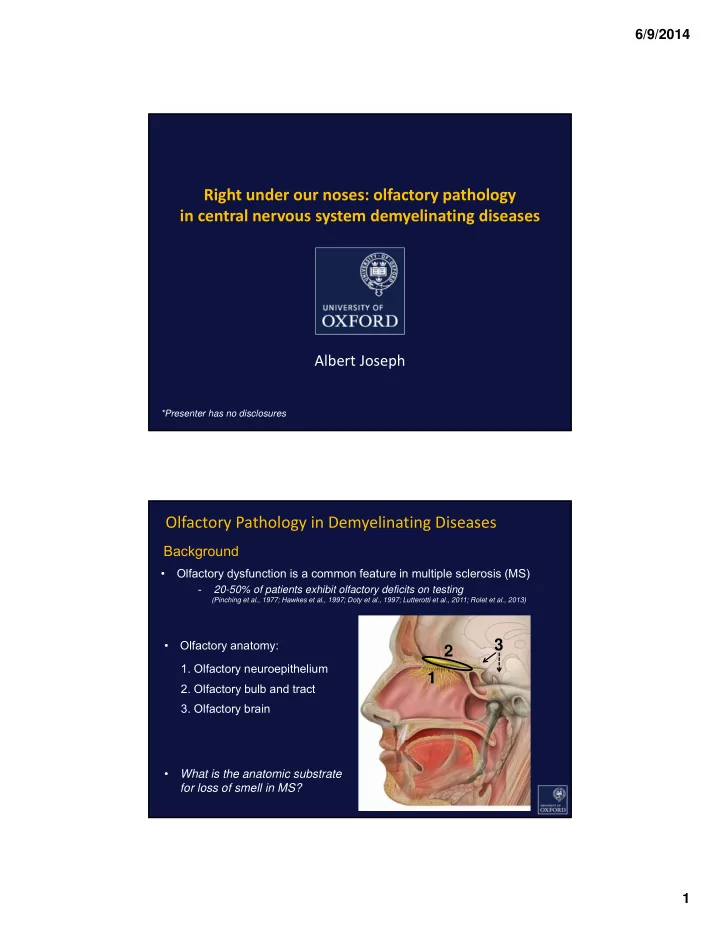

6/9/2014 Right under our noses: olfactory pathology in central nervous system demyelinating diseases Albert Joseph *Presenter has no disclosures Olfactory Pathology in Demyelinating Diseases Background • Olfactory dysfunction is a common feature in multiple sclerosis (MS) - 20-50% of patients exhibit olfactory deficits on testing (Pinching et al., 1977; Hawkes et al., 1997; Doty et al., 1997; Lutterotti et al., 2011; Rolet et al., 2013) • Olfactory anatomy: 3 2 1. Olfactory neuroepithelium 1 2. Olfactory bulb and tract 3. Olfactory brain • What is the anatomic substrate for loss of smell in MS? 1
6/9/2014 Olfactory Pathology in Demyelinating Diseases Background At end of 19 th century Gowers described MS pathology in detail • Gowers, A Manual of Diseases of the Nervous System, 1886 Olfactory Pathology in Demyelinating Diseases Background • Zimmerman and Netsky (1950) NO olfactory bulb/tract DM in MS (n=8) Olfactory loss α MRI lesion burden in olfactory brain Doty et al., NEJM 1997 • Shifted search for olfactory dysfunction in olfactory brain 2
6/9/2014 Olfactory Pathology in Demyelinating Diseases Research Hypothesis That olfactory bulb/tract are pathologically affected in MS and in other demyelinating diseases Olfactory Pathology in Demyelinating Diseases Case Selection • Human autopsy cohort of pathologically confirmed cases ‘Demyelinating’ Diseases Multiple sclerosis (MS) (n=17) Neuromyelitis optica (NMO) (n=3) Acute disseminated encephalomyelitis (ADEM) (n=7) Neuroinflammatory Disease Neurodegenerative Disease Herpes Simplex Encephalitis (HSE) (n=3) Alzheimer’s Disease (AD) (n=4) Non-neurologic Controls (n=8) 3
6/9/2014 Olfactory Pathology in Demyelinating Diseases Materials and Methods • Coronally sliced brains realigned olfactory bulbs/tracts sampled • Subjacent inferofrontal cortex and hippocampus sampled, where available Olfactory Pathology in Demyelinating Diseases Materials and Methods Demyelination • Areas of DM quantified and related to total sampled area PLP stain for myelin 4
6/9/2014 Olfactory Pathology in Demyelinating Diseases Materials and Methods Inflammation • T- and B-lymphocytes and macrophages/microglia scored semi-quantitatively 0 no cells/field; + 1 cell/field; ++ 2-4 cells/field; +++ > 4 cells/field Axonal loss Palmgren Silver stain for axons Olfactory Pathology in Demyelinating Diseases Results Cohort • Age and duration of disease differed significantly b/w disease groups 5
6/9/2014 Olfactory Pathology in Demyelinating Diseases Results Demyelination • Myelination pattern in olfactory bulb/tract was complex bulb tract 0/8 cases (0%) Olfactory Pathology in Demyelinating Diseases Results Demyelination 12/17 cases (70.6%) 2/3 cases (66.7%) 3/7 cases (42.9%) Proportional DM Area (18.6%) Proportional DM Area (2.9%) Proportional DM Area (3.0%) • MS / NMO plaques all chronic; ADEM plaques all active • HSE, AD, and non-neurologic controls no demyelination 6
6/9/2014 Olfactory Pathology in Demyelinating Diseases Results Inflammation • Olfactory bulb/tract inflammation observed in all disease groups (in parenchyma, perivascular space, meninges) Olfactory Pathology in Demyelinating Diseases Results Macrophages (PG-M1) T-cells (CD3+) Inflammation (acute) ADEM Striking inflammation in acute neurologic diseases HSE 7
6/9/2014 Olfactory Pathology in Demyelinating Diseases Results Axonal Loss 1.8 1.7 1.6 Semiquantitative Score 1.4 1.2 1 1 0.8 0.8 0.7 0.6 0.4 0.4 0.3 0.2 0 Control MS NMO ADEM HSE AD • Axonal loss was most pronounced in MS and Alzheimer’s disease Olfactory Pathology in Demyelinating Diseases Results Relationship between olfactory and cortical demyelination Inferofrontal Cortical Lesions • 180 lesions from 73 inferofrontal cortical blocks juxtaposed to analysed olfactory bulb/tract from 22 cases (MS, n=15; ADEM, n=7) Hippocampal Lesions • 23 lesions from 27 hippocampal blocks from 12 cases (MS, n=7; ADEM, n=5) **p = 0.01 8
6/9/2014 Olfactory Pathology in Demyelinating Diseases Conclusions • Olfactory bulb/tract demyelination: - frequent - can occur early - can be highly inflammatory - relates to subjacent cortical DM • Alternative explanation for loss of smell in MS and other demyelinating diseases? • Role of olfactory system in pathogenesis of demyelinating diseases? Olfactory Pathology in Demyelinating Diseases Acknowledgements • Dr. Gabriele De Luca (AANF/CMSC John F. Kurtzke Clinician-Scientist) • Prof. Margaret Esiri, Neuropathology, University of Oxford Oxford Brain Bank • Patients and families who donated brains for research Nuffield Department of Clinical Neurosciences • Dr. Jithin George, MS Fellow , Oxford University Hospitals (OUH) NHS Trust • Mr. Richard Yates, D.Phil. Student, University of Oxford • Dr. Monika Hofer, Consultant Neuropathologist, OUH NHS Trust 9
Recommend
More recommend